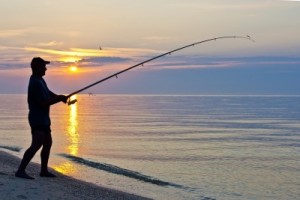 Most people think you need a fancy boat with plenty of fishing equipment to fish. But, some of the greatest fishing actually takes place in the surf on the beach. There is something fine and natural about getting next to nature, and nowhere is it easier for coastal anglers than surf fishing. You are barefoot with the surf booming close by, the wind blowing and not another human being in sight. You may see an occasional seagull. If it is cool weather, however, you might want to wear shoes. There are actually fishing boots designed for surf fishing.
Most people think you need a fancy boat with plenty of fishing equipment to fish. But, some of the greatest fishing actually takes place in the surf on the beach. There is something fine and natural about getting next to nature, and nowhere is it easier for coastal anglers than surf fishing. You are barefoot with the surf booming close by, the wind blowing and not another human being in sight. You may see an occasional seagull. If it is cool weather, however, you might want to wear shoes. There are actually fishing boots designed for surf fishing.
Picking a spot to surf fish is crucial. Timing is everything. If you are one of those that can read the surf that is a plus. However, if you can’t, locate your favorite stretch of beach and study the line of breakers off of the beach. They are usually formed by first and second sandbars, where a line of waves break white. There might even be a third sandbar in deeper water. Watch for the break in the second and third bars, where the water flows back out to the sea. This excess water is where the rip currents may drag a swimmer offshore for a short distance. This same current draws natural food out to the fish, and that’s where your bait should be. It is not a bad idea to check out where the locals fish. If you see a cluster of 18 long rods sitting in sand spikes, it is likely there will be good fishing found. Incoming tides are often best early in the morning when the light is low. Game fish will generally prowl close to the beach. Early is good because the families are not out yet.
If you are serious about reeling in the big one, you should purchase a surf rod from 12 10 15 feet in length with big line guides, designed to launch a bait and weight up to 100 yards offshore. A big saltwater spinning reel packed with 20 or 25 pound line can take the abuse of a serious cast and still subdue sizeable fish. Lighter line might snap in mid-cast, while heavier line takes up too much real-spool capacity. You can bring a smaller rod for casting at closer fish, especially during high tide. Some surf veterans come equipped with multiple outfits. The big surf rods are set into sand spikes, which are PVC pipes – some three to four feet long, sharpened at one end, and usually about 2 inches in diameter. These are driven into the sand and provide a stable platform for your rods. It is never a good idea to use buckets or coolers that will not stop a rod from being pulled down into sand or water. You do not want an expensive reel to fall into gritty sand or saltwater. After that, set the reel’s drag light when using regular j-hooks and stay close by, because you have to react quickly when a fish hits. With circle hooks, the fish hook themselves. Make sure the drag is set with several pounds of pressure – you want a nice bend in that rod, so the fish gets hooked. Get advice from the local tackle shop. They will know what works best in the area where you decide to fish.
Fishing in the surf on the beach can be the best of two worlds. If you love the beach and you enjoy the sport of fishing, the sound of the surf along with the exhilaration of landing the big one – what could be better?
Source: “How to Read the Beach for Surf Fishing.” How to Read the Beach for Surf Fishing. Web. 15 July 2013.
Follow Us: Facebook – Foursquare – Twitter – YouTube – LinkedIn
